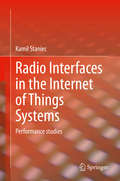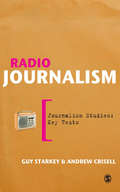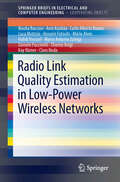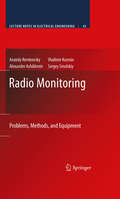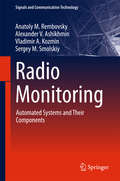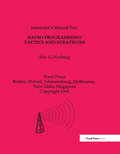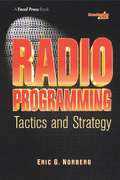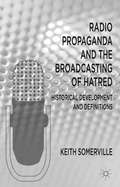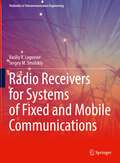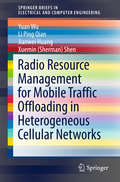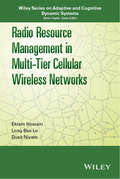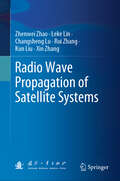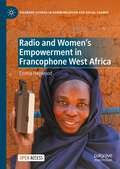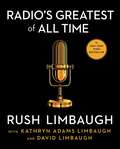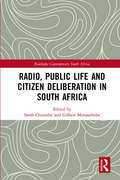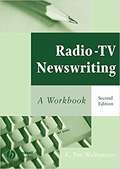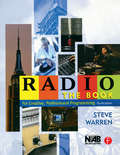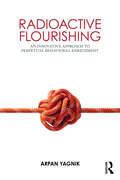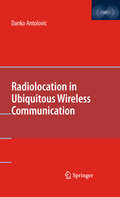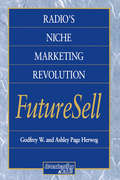- Table View
- List View
Radio Goes to War: The Cultural Politics of Propaganda During World War II
by Gerd HortenAs a comprehensive and in-depth look at the role of domestic radio in the United States during the Second World War, this study demonstrates how radio broadcasting played a crucial role both in government propaganda and within the context of the broader cultural and political transformations of wartime America and argues that no medium merged entertainment, propaganda, and advertising more effectively than radio.
Radio Interfaces in the Internet of Things Systems: Performance studies
by Kamil StaniecThe book gives a broad overview of the Internet of Things (IoT) concept from various angles. The book provides rationale for: the concept development; its regulatory and technical background associated aspects such as the ambient and edge intelligence; fog computing; capillary networks and machine-type communications; etc. Each of these items is then extended in further respective chapters that deal with technicalities behind them. Chapters: 2-5, 8, 10-11 are addressed to those who seek expository IoT-related information on aspects such as the pathloss calculation, narrowband radio interfaces, radiation masks, spectrum matters, medium access control, and a transmission frame construction. That section ends with an exhaustive description of the six most popular IoT systems: LoRa, Weightless, SigFox, NB-IoT, LTE-M(TC) and EC-GSM IoT. Specialists and network designers may find chapters 6 and 7 interesting where a novel methodology is proposed for testing narrowband IoT systems performance for immunity to electromagnetic interference (EMI) and multipath propagation, both emulated in artificial conditions of the anechoic and the reverberation chamber.
Radio Journalism (Journalism Studies: Key Texts)
by Andrew Crisell Guy Starkey"This is not another turgid guide to digital editing, writing for radio and the structure of a newsroom team. It is an ambitious and accessible study that combines a succinct narrative history of radio journalism with an analysis of its power in the public sphere. It describes the development of British audio broadcasting before locating it in an international context and contemplating the contours of the convergent future. Such ambition is often the prelude to failure. Instead, Starkey and Crisell have written a precious introduction to the theory, practice and purposes of radio journalism that will be very useful to serious students of the subject... This is a very good book." - THE (Times Higher Education) Radio Journalism introduduces key themes in journalism studies to explore what makes radio reporting distinctive and lay out the claims for radio's critical importance in the news landscape. With their extensive experience in radio production and academica, authors Guy Starkey and Andrew Crisell take readers on a tour through the past, present and future of radio broadcasting, from the infancy of the BBC in the 1920s up to the prospect of rolling news delivered to mobile telephones. Grounding each chapter in a survey of scholarly writing on the radio, they explore the connections between politics, policy and practice, inviting critical reflection on who radio professionals are, what they do and why. Putting theory and practice into dialogue, this book is the perfect bridge between unreflective production manuals and generalised media theory texts. Witty and engaging, Radio Journalism provides an essential framework for understanding the continuing relevance of radio journalism as a profession, set of practices and arena for critical debate. ks within particular types of journalism; a review of contemporary practices; social demographics; a comparative analysis of practices around the world; a summary of main conceptual approaches; an indication of future directions; recommendations for further reading. This strong organization resembles a template for a course outline. This is intentional because the series is aimed both at students and their practice-based lecturers, who often come straight from industry and need time to adjust to the academic environment... [The series] achieves its aim to bridge the sometimes too evident dissonance between journalism theory and practice... They successfully situate discussions about journalism in social and historical contexts. We see the faces of individual journalists, the circumstances of news production, the relationship with owners, the battle between the public service and the profit nature of news, the relevance of journalism work. The detailed account of the conditions under which newspaper, radio and alternative journalism is produced and performed make the Journalism Studies: Key Texts series mandatory reading for both journalism students and their lecturers' - Verica Rupar, Journalism Studies
Radio Link Quality Estimation in Low-Power Wireless Networks
by Marco Antonio Zuniga Carlo Alberto Boano Claro Noda Luca Mottola Habib Youssef Hossein Fotouhi Daniele Puccinelli Anis Koubâa Kay Römer Mário Alves Nouha Baccour Thiemo VoigtThis book provides a comprehensive survey on related work for radio link quality estimation, which covers the characteristics of low-power links, the fundamental concepts of link quality estimation in wireless sensor networks, a taxonomy of existing link quality estimators and their performance analysis. It then shows how link quality estimation can be used for designing protocols and mechanisms such as routing and hand-off. The final part is dedicated to radio interference estimation, generation and mitigation.
Radio Monitoring
by Alexander Ashikhmin Vladimir Kozmin Sergey M. Smolskiy Anatoly RembovskyRadio Monitoring: Problems, Methods, and Equipment offers a unified approach to fundamental aspects of Automated Radio Monitoring (ARM). The authors discuss the development, modeling, design, and manufacture of ARM systems. Data from established and recent research are presented and recommendations are made on methods and approaches for solving common problems in ARM. The authors also provide classification and detailed descriptions of modern high-efficient hardware-software ARM equipment, including the equipment for detection, radio direction-finding, parameters measurement and their analysis, and the identification and localization of the electromagnetic field sources. Examples of ARM equipment structure, applications, and software are provided to manage a variety of complicated interference environment in the industrial centers, inside of the buildings, and in the open terrain. This book provides a reference for professionals and researchers interested in deploying ARM technology as a tool for solving problems from radio frequency spectrum usage control.
Radio Monitoring: Problems, Methods And Equipment (Lecture Notes In Electrical Engineering #43)
by Sergey M. Smolskiy Anatoly M. Rembovsky Alexander V. Ashikhmin Vladimir A. KozminThis book discusses the architecture of modern automated systems for spectrum monitoring including automation components: technical means for spectrum monitoring, special software and engineering infrastructure. The problems of automated system development for search and localization of unauthorized radio emission sources in open localities, mathematical methods and algorithms for modulation of parameter measurements for wireless communication as well as issues of identification and localization of radio emission sources are considered. Constructive solutions and modern technical means for radio monitoring and their application are given. Numerous examples are described for the implementation of automated systems, digital radio receivers and radio direction-finders, analyzers of parameters for GSM, CDMA, LTE, DVB-T/T2, Wi-Fi, DMR, P25, TETRA and DECT signals. Practical implementations of the described methods are presented in applied software packages and in radio monitoring equipment.
Radio Programming Tactics and Strategies
by NorbertFirst published in 2002. Routledge is an imprint of Taylor & Francis, an informa company.
Radio Programming: Tactics And Strategy (Broadcasting And Cable Ser.)
by Eric NorbergA practical handbook for programming directors, this guide focuses on achieving specific objectives in today's modern, competitive environment. Radio Programming is designed to convey underlying principles and to assist the programmer in accomplishing specific objectives, without mandating exact implementation methods. Instead, it empowers station management and the PD to implement strategies that will work for the particular format and market niche. Radio Programming will be helpful for neophytes in programming, experienced programmers seeking further growth, air talent seeking to develop skills, and general managers trying to understand programming and effectively manage program directors without stifling creativity. It will also help general managers hire effective programmers.Eric Norberg is the editor and publisher of the Adult Contemporary Music Research Letter and a radio consultant. He has worked as a program director at several radio stations, as on-air talent and general manager, and has also operated a radio production company. For fourteen years he has written a weekly column on radio programming for The Gavin Report, a radio trade publication.
Radio Propaganda and the Broadcasting of Hatred
by Keith SomervilleAn exposition and analysis of the development of propaganda, focusing on how the development of radio transformed the delivery and impact of propaganda and led to the use of radio to incite hatred and violence.
Radio Receivers for Systems of Fixed and Mobile Communications (Textbooks in Telecommunication Engineering)
by Sergey M. Smolskiy Vasiliy V. LogvinovThe textbook acquaints the reader with the architecture of receivers of analog and digital radio systems, helps to study the stages of designing a modern radio receiver and reveals the reasons and methods for its effective operation in networks for various purposes. Particular attention is paid to the methods of generating and processing signals in the receivers of digital systems with multiple access, which make it possible to provide data transfer rates close to the maximum possible (according to Shannon). As a textbook for students studying methods of optimal signal reception, the book will also be useful to specialists in the field of telecommunications involved in the development of radio receivers. The book shows how the development of theoretical, circuitry and integrated technologies led to the active introduction of algorithmic methods for signal processing changed both the design of receivers and the methods of forming the information flow in free space (MIMO, beamforming). The creation of a global 5G network based on heterogeneous networks puts forward new requirements for the architecture of receivers, which are determined by the requirements to achieve high data rates, low time delays or use in networks with coordinated multipoint transmission and reception (CoMP). To consolidate the knowledge gained, the book includes a complete set of materials for online classes, including questions and answers, a guide to solving problems for each chapter, and computer modeling units of receivers in the MicroCAP environment, based on preliminary calculations.
Radio Resource Management for Mobile Traffic Offloading in Heterogeneous Cellular Networks
by Xuemin Sherman Shen Jianwei Huang Yuan Wu Li Ping QianThis SpringerBrief offers two concrete design examples for traffic offloading. The first is an optimal resource allocation for small-cell based traffic offloading that aims at minimizing mobile users' data cost. The second is an optimal resource allocation for device-to-device assisted traffic offloading that also minimizes the total energy consumption and cellular link usage (while providing an overview of the challenging issues). Both examples illustrate the importance of proper resource allocation to the success of traffic offloading, show the consequent performance advantages of executing optimal resource allocation, and present the methodologies to achieve the corresponding optimal offloading solution for traffic offloading in heterogeneous cellular networks. The authors also include an overview of heterogeneous cellular networks and explain different traffic offloading paradigms ranging from uplink traffic offloading through small cells to downlink traffic offloading via mobile device-to-device cooperation. This brief is an excellent resource for postgraduate students studying advanced-level topics in wireless communications and networking. Researchers, engineers and professionals working in related fields will also find this brief a valuable resource tool.
Radio Resource Management in Multi-Tier Cellular Wireless Networks
by Dusit Niyato Ekram Hossain Long Bao LeProviding an extensive overview of the radio resource management problem in femtocell networks, this invaluable book considers both code division multiple access femtocells and orthogonal frequency-division multiple access femtocells. In addition to incorporating current research on this topic, the book also covers technical challenges in femtocell deployment, provides readers with a variety of approaches to resource allocation and a comparison of their effectiveness, explains how to model various networks using Stochastic geometry and shot noise theory, and much more.
Radio Utopia: Postwar Audio Documentary in the Public Interest
by Matthew C. EhrlichAs World War II drew to a close and radio news was popularized through overseas broadcasting, journalists and dramatists began to build upon the unprecedented success of war reporting on the radio by creating audio documentaries. Focusing particularly on the work of radio luminaries such as Edward R. Murrow, Fred Friendly, Norman Corwin, and Erik Barnouw, Radio Utopia: Postwar Audio Documentary in the Public Interest traces this crucial phase in American radio history, significant not only for its timing immediately before television, but also because it bridges the gap between the end of the World Wars and the beginning of the Cold War. Matthew C. Ehrlich closely examines the production of audio documentaries disseminated by major American commercial broadcast networks CBS, NBC, and ABC from 1945 to 1951. Audio documentary programs educated Americans about juvenile delinquency, slums, race relations, venereal disease, atomic energy, arms control, and other issues of public interest, but they typically stopped short of calling for radical change. Drawing on rare recordings and scripts, Ehrlich traces a crucial phase in the evolution of news documentary, as docudramas featuring actors were supplanted by reality-based programs that took advantage of new recording technology. Paralleling that shift from drama to realism was a shift in liberal thought from dreams of world peace to uneasy adjustments to a cold war mentality. Influenced by corporate competition and government regulations, radio programming reflected shifts in a range of political thought that included pacifism, liberalism, and McCarthyism. In showing how programming highlighted contradictions within journalism and documentary, Radio Utopia reveals radio's response to the political, economic, and cultural upheaval of the post-war era.
Radio Wave Propagation of Satellite Systems
by Xin Zhang Rui Zhang Kun Liu Zhenwei Zhao Leke Lin Changsheng LuThis book highlights the fundamental theories and prediction methods of radiowave propagation for the design, building, and operation of contemporary satellite systems. The primary objective of this book is to inquire into whether and how it is possible in a democracy to effectively decrease short-sighted policies. Although the commonplace expression “responsibility to future generations” has become firmly established in public and political vocabulary, its operational meaning and practice are not as well understood and have not yet been systematically evaluated. It still has not been successfully translated into viable ethical and theoretical concepts that can guide public policies and action. How can modes of governance and established priorities compatible with the well-being of future generations be created? This book identifies the conditions, and the obstacles, for such future-oriented governance. To meet the needs of diverse satellite applications, the book covers the main factors that affect radiowave propagation, including the clear-air effects, the hydrometeor effects, the ionospheric effects, the earth's surface reflection, and the local environmental effects. To enhance the prediction of radiowave propagation, the book elaborates on the characteristics of radio meteorological and ionospheric environments. It also summarizes research progress on the prediction methods of radio noise and interference coordination for satellite systems. The fade mitigation techniques and the propagation analysis of satellite system design are discussed. Providing a comprehensive summary of common practices and latest advances, the book is intended for researchers and engineers engaged in the study and practice of satellite systems, radio propagation, and its applications.
Radio and Women's Empowerment in Francophone West Africa (Palgrave Studies in Communication for Social Change)
by Emma HeywoodThis open access book breaks new ground by examining the significant role played by radio in empowering women in three Francophone West African countries: Mali, Niger and Burkina Faso.It examines the representation and perception of key themes broadcast by radio and associated with women’s empowerment in the three countries. Each chapter contextualises a specific topic in the country and then explores discrete aspects of radio’s provision. The topics covered in the chapters are women’s political engagement; women and finances; women and life within marriage; inheritance; women’s involvement in radio structures; and radio, internally displaced women, and trauma.Given the social, economic and political vulnerability and deteriorating security situation of the three countries, this book provides a timely and meaningful contribution to acknowledging and understanding the vital role of radio in women’s empowerment.
Radio and the Gendered Soundscape
by Christine EhrickThis book is a history of women, radio, and the gendered constructions of voice and sound in Buenos Aires, Argentina, and Montevideo, Uruguay. Through the stories of five women and one radio station, this study makes a substantial theoretical contribution to the study of gender, mass media, and political culture and expands our knowledge of these issues beyond the US and Western Europe. Included here is a study of the first all-women's radio station in the Western Hemisphere, an Argentine comedian known as 'Chaplin in Skirts', an author of titillating dramatic serials and, of course, Argentine First Lady 'Evita' Perón. Through the concept of the gendered soundscape, this study integrates sound studies and gender history in new ways, asking readers to consider both the female voice in history and the sonic dimensions of gender.
Radio and the Politics of Sound in Interwar France, 1921–1939
by Rebecca P. ScalesIn December 1921, France broadcast its first public radio program from a transmitter on the Eiffel Tower. In the decade that followed, radio evolved into a mass media capable of reaching millions. Crowds flocked to loudspeakers on city streets to listen to propaganda, children clustered around classroom radios, and families tuned in from their living rooms. Radio and the Politics of Sound in Interwar France, 1921–1939 examines the impact of this auditory culture on French society and politics, revealing how broadcasting became a new platform for political engagement, transforming the act of listening into an important, if highly contested, practice of citizenship. Rejecting models of broadcasting as the weapon of totalitarian regimes or a tool for forging democracy from above, the book offers a more nuanced picture of the politics of radio by uncovering competing interpretations of listening and diverse uses of broadcast sound that flourished between the world wars.
Radio's Greatest of All Time
by Rush Limbaugh#1 NEW YORK TIMES BESTSELLER A collection of Rush Limbaugh&’s greatest on-air moments, with special commentary and personal stories from his beloved widow, Kathryn Limbaugh, and brother, David Limbaugh.For more than thirty years, millions of listeners tuned in to hear Rush Limbaugh&’s voice. At its peak, The Rush Limbaugh Show aired on more than 650 radio stations nationwide, and his inimitable commentary and distinctive sense of humor garnered a devoted audience that celebrated with him when he received the Presidential Medal of Freedom in 2020. Rush&’s passing the following year sent shock waves through the conservative and broadcasting communities. In this timeless collection of his best work, his triumphant legacy as the greatest voice for conservatism is cemented in history. When Rush&’s dear friend Vince Flynn first suggested the idea of this book, Rush considered the task daunting. &“How can I possibly select the best of the best,&” he joked, &“from all the years of pure genius?&” Over time, Rush came to love this project immensely, and recalled incredible details from his childhood and early career. Featuring commentary from loved ones, family, friends, and prominent figures such as President Donald Trump, Supreme Court Justice Clarence Thomas, Governor Ron DeSantis, and more, Radio&’s Greatest of All Time is the ultimate gift for any devoted listener and leaves no doubt about his profound impact on this country.
Radio's Second Century: Past, Present, and Future Perspectives
by Bruce Mims John Allen Hendricks Daniel Riffe Brad Clark Mark Ward Lu Wu Laith Zuraikat Joseph R. Blaney David Crider Rachel Sussman-Wander Kaplan John F. Barber Emily W. Easton John Mark Dempsey Anjuli Joshi Brekke Anne F. MacLennan Archie McLean Michael Nevradakis Simon OrderOne of the first books to examine the status of broadcasting on its one hundredth anniversary, Radio’s Second Century investigates both vanguard and perennial topics relevant to radio’s past, present, and future. As the radio industry enters its second century of existence, it continues to be a dominant mass medium with almost total listenership saturation despite rapid technological advancements that provide alternatives for consumers. Lasting influences such as on-air personalities, audience behavior, fan relationships, and localism are analyzed as well as contemporary issues including social and digital media. Other essays examine the regulatory concerns that continue to exist for public radio, commercial radio, and community radio, and discuss the hindrances and challenges posed by government regulation with an emphasis on both American and international perspectives. Radio’s impact on cultural hegemony through creative programming content in the areas of religion, ethnic inclusivity, and gender parity is also explored. Taken together, this volume compromises a meaningful insight into the broadcast industry’s continuing power to inform and entertain listeners around the world via its oldest mass medium--radio.
Radio, Public Life and Citizen Deliberation in South Africa (Routledge Contemporary South Africa)
by Sarah ChiumbuThis book critically analyses the important role of radio in public life in post-apartheid South Africa. As the most widespread and popular form of communication in the country, radio occupies an essential space in the deliberation and the construction of public opinion in South Africa. From just a few state-controlled stations during the apartheid era, there are now more than 100 radio stations, reaching vast swathes of the population and providing an important space for citizens to air their views and take part in significant socio-economic and political issues of the country. The various contributors to this book demonstrate that whilst print and television media often serve elite interests and audiences, the low cost and flexibility of radio has helped it to create a ‘common’ space for national dialogue and deliberation. The book also investigates the ways in which digital technologies have enhanced the consumption of radio and produced a sense of imagined community for citizens, including those in marginalised communities and rural areas. This book will be of interest to researchers with an interest in media, politics and culture in South Africa specifically, as well as those with an interest in broadcast media more generally.
Radio-TV Newswriting 2e: A Workbook
by K. Tim WulfemeyerRadio-TV news must be written in a simple, direct manner so a newscaster can read the copy easily and communicate effectively in a way that will help listeners and viewers understand complex issues and events the first time they hear about them. Radio - TV Newswriting: A Workbook, Second Edition gives students abundant opportunities to learn, practice and develop sound foundations for writing radio-TV news. <P><P>More than 100 pages of true-to-life writing exercises involve students in practicing techniques, skills and situations. Radio exercises include writing reader stories, actuality stories, wraparound stories, voicer stories, live reports and newscasts. TV exercises include writing reader stories, full-screen graphics stories, voice-overs, studio packages (VO/SOT), soundbites, reporter packages and live shots. Students will write stories from wire copy, news releases, fact sheets and reporters’ notes. New to this edition is a section devoted to writing for a station or network web site, including exercises in web writing.
Radio: A Fun Practical Programming Manual And Idea Book For Program Directors And Operations Managers
by Steve WarrenAs entertaining as it is educational, Radio: The Book is a must-have guide to success for anyone interested in a career in radio. Providing a wealth of information and relating his own personal experiences, veteran radio personality, Program Director and Programming Consultant Steve Warren shares trade secrets and industry know-how that would usually take years to accumulate through experience. An invaluable advantage over your competition, this "cheat-sheet" for the radio programmer includes practical advice regarding:·Radio as a career--from tips on getting started to job negotiations·Programming--talk radio and music, from format science to picking the hits·Relationships with listeners--everything from staying in touch with your audience to public image·Branding, marketing, and advertising the radio station·Research--music tests, audience analysis, ratings, and more·Practical information about management policies·Radio realities--information on rules and regulationsThis latest edition has been updated to include: ·Important updates on an ever-evolving field·Essential forms for radio station functions--production orders, personnel files, absentee reports, PSA schedules, format clocks, remote schedule, and more.to be accompanied by an on-line section of electronic forms for convenience·Ideas for successfully programming in new radio formats like satellite, internet, and cableIn such a competitive industry where formal training can be hard to come by, Radio: The Book, 4e, is a short-cut to the fast track for current and future programmers and program directors. With an active radio broadcast career that is still exploring new ideas following s more than forty years at some of America's most prestigious radio stations (including WNBC, WHN, WNEW, and CBS radio), Steve Warren is more than qualified to mentor readers. Steve has competed successfully in all music formats from Easy Listening to Country to Top 40 to Oldies, always putting the listener first and now, putting you first.
Radioactive Flourishing: An Innovative Approach to Perpetual Behavioral Enrichment
by Arpan YagnikRadioactive Flourishing is for seekers of lasting happiness and peace. Radioactive Flourishing supplies cognitive insights for eventual behavioral stability. The USP of the book is its flipped human response toward instability. This book’s primary goal is to help people learn ways to flourish individually despite being surrounded by instability.This book is intentionally written in the "katha" style, which means that there are numerous relatable stories and a consistent journey from the core to the periphery, then to the tangent, and back. The implicit and explicit repetition of the key manifest enables the core intervening stimulation to encourage its readers to dig deeper and find solid footing in their flourishing being. This book is for seekers of happiness and peace.This book will be useful to students, researchers, young professionals, and faculty members working in the fields of business administration, psychology, start-ups, finance, entrepreneurship, and communication. It will also be an invaluable resource for aspiring leaders and students of life.
Radiolocation in Ubiquitous Wireless Communication
by Danko AntolovicThe subject of the book is application of multi-antenna radiolocation to the environment of fast, ubiquitous wireless communication among portable devices. It is a systematic presentation of the author's research and development in the field, within the 802.11b standard, while explaining the general principles and exploring applications to other standards and situations. The purpose is to fill a gap in the current technical literature and present the issues involved in locating mobile wireless network agents, in a single volume, accessible to system designers and other practitioners in the wireless field.
Radios Niche Marketing Revolution FutureSell (Broadcasting And Cable Ser.)
by Ashley Herweg Godfrey HerwegRadio's niche marketing revolution evolved to address the problems of market fragmentation. These problems are responsible for steep declines in traditional media revenues. Market fragmentation, happening in every market across the globe, has led marketers and media into the new era of niche marketing. Mass-marketing strategies are obsolete. Radio, cable (wired and unwired), and television are being forced to alter the way they present their products, promotions, and marketing strategies. FutureSell provides radio professionals with the advanced skills and systems to turn niche marketing into a profitable approach for their own stations. Your clients don't want to buy advertising period. They do, however, want to sell their products and services. Your advertisers' markets are also fragmenting. Cutting-edge companies now seek ways to learn their customers' smallest needs and cater to their customers' perceptions. Yet, very few businesses or ad agencies know how to conduct niche or one-to-one marketing. With the techniques introduced in this book, you can create new revenue streams while upgrading your largest advertisers. The ideas you'll encounter work for multi-national media conglomerates, stations in small markets, and duopolies in any market size. Owners, group heads, managers, salespeople, programmers, copywriters, and office staff will gain valuable insight to make their jobs easier and more productive. Radio people, ad agency executives, and advertisers will discover a money-making glimpse into the future.

